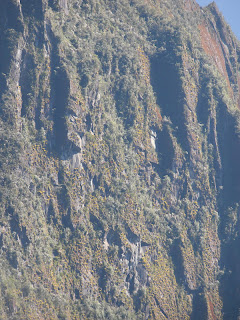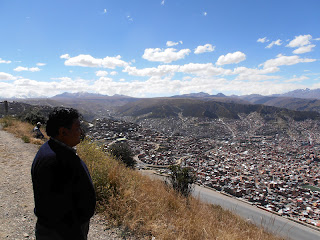It is a long bumpy minibus ride to the railway station at Ollantaytambo where you get your train. There wasn't a lot of chat along the way. One guy managed to snore the whole way there. It wasn't the snoring that annoyed me as much as his ability to sleep through the rough ride.whilst the rest of us bounced and lurched around.
The station was unsurprisingly quiet at that time in the morning. There was a train waiting, its big diesel engine ticking over with a deep throaty gurgle. I tried to get on this virtually empty train but was told I had to wait for mine which was an hour wait. Why? I don't know as there are no stops to pick up passengers along the way. It was cold at that time in the morning and the cafe didn't open for another 30 minutes.
I tried to take some pictures as we headed down the valley towards Agua Calientes (the town at the bottom of Machu Picchu (MP from here on). But they were rubbish, partly because the track is so bumpy, it feels like the train has square wheels.
You do stop twice, to drop off the Hikers - there is a 4 day & a 1 day hike. both must be pretty tough and as I am not a hiker I had no intention of doing those!
At Agua C you are met by tour guides and taken straight to more buses. These whisk you straight up the mountain to the entrance to MP. At the entrance to MP is an hotel called the Sanctuary, I believe it is $1,000 a night according to my tour guide. I didn't stay there!
2 Americans, 2 from Hong Kong and I were ushered towards a larger group with an English speaking guide. A few steep flights of stone steps and you are there!
The scale of the place is the most surprising thing, the number of buildings and the extent of the terracing are incredible given the amount of time, labour and effort it must have taken to work the mountain in to these features.
To climb the high peak you have to book and unfortunately it was fully booked for weeks ni advance. It takes about an hour to climb to the top (where the priests used to do their astrology) and apparently they have about 6 deaths per year on the trek up, so I wasn't too disappointed to miss it!
You could take 1000 pictures (Wilks probably did) but I will leave you with just a few. I am sure you can find far better ones on the Interweb.
The Inca only lasted about 400 years as the dominant tribe and MP lays at the centre of their known world and controlled the other tribes with is vantage point. An American Hiram Bingham is credited with opening MP to the wider world in 1911. He is also discredited with exporting 40,000 artefact's (which the Peruvians would like back).
There is a lot of symbolism the "green mounds" you see represent the head and partly folded wings of a Condor (MP is also known as Condor City). They then laid out the town to represent the rest of the body. You can see it from an aerial view picture. Some of the buildings are set out to form a crocodile which you can see to the right in this picture (tail nearest the camera)
In the rock face is the image of a Puma (you can just make it out but perhaps not from this picture)
After about 2 hours the tour is over and you are left to wander around as you want to. Once done you catch a bus back down to the village below.
Agua Calientes has about as many restaurants & gift shops as it is possible to cram in to such a small space. It still manages to have some charm about it.
I stayed on night there rather than get back to Cuzco late and tired and I am glad I did.although there was no hot water at the hotel, this seemed rather ironic for a town called Agua Calientes.
The train really does thread its way right into town, the only town i know where the main road is a railroad. On the journey back we got an "inflight" meal and a fashion show by the train staff, modelling alpaca jumpers, shawls and the like. They seemed to do a roaring trade too. How long before Branson introduces that on his flights! May be worth watching!
It was a tremendous place to visit and despite the overt tourism it is somewhere well worth visiting if you are ever in the area. Oh and by the way, it is not wheelchair friendly!






















































